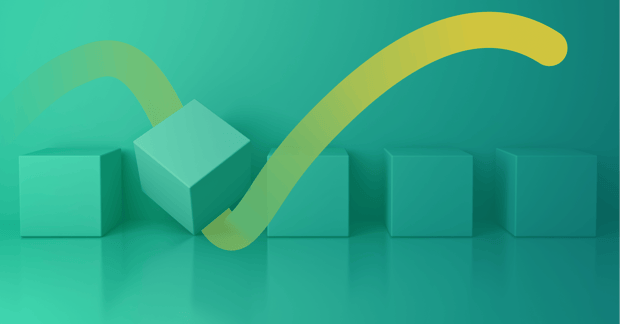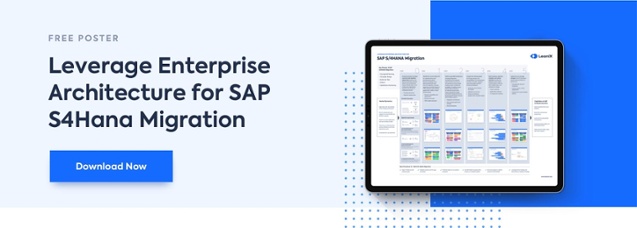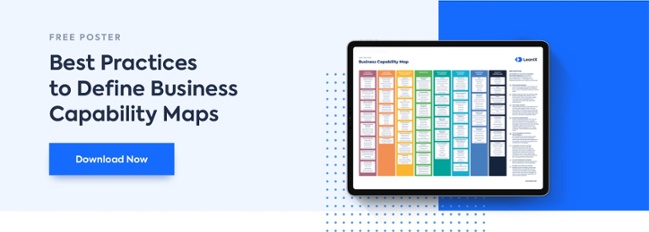
Enterprise resource planning (ERP) transformation is vital for scaling your business and maintaining agility during difficult times. Let's explore why getting visibility of your current state using enterprise architecture management (EAM) is the first of three steps in any ERP transformation, particularly an upgrade to SAP S/4HANA.
SAP software is the gold standard for enterprise resource planning (ERP) and an upgrade to SAP S/4HANA is guaranteed to bring any organization a variety of new capabilities to improve efficiency and agility. Whichever ERP platform you use, however, you'll eventually need to replace or migrate to a new version or different platform.
Unfortunately, ERP transformation is a complex and nuanced undertaking that involves far more than just a software upgrade. Transformation requires updating and remapping all of your business processes across your entire organization.
According to a Gartner report, up to 75% of ERP transformation initiatives fail because of this complexity. The title of that report is also extremely relevant: ERP Implementation: To Avoid Project Failure, Assess the Impact of Change Before Starting Configuration.
In this series of articles, we'll take you through the three pillars of ERP transformation. We'll start this article with why getting visibility of your current state should be your first step, and how you can go about it.
The key to doing this is good enterprise architecture management (EAM) using a tool like the LeanIX EAM platform. To find out more, download our free white paper on how EAM supports ERP transformation:
What Is Enterprise Resource Planning (ERP) Transformation?
Enterprise resource planning (ERP) software like SAP S/4HANA is often described as the 'central nervous system of your business'. It's a software platform that connects, monitors and co-ordinates all the various capabilities and outputs of your organization.
ERP software is vital for any enterprise once it reaches a certain scale. Yet, like any other software, ERP tools will eventually need to be updated and likely migrated to the cloud, given the advantages that provides.
As BCG explained in an article:
"New ERP platforms like SAP S/4HANA can deliver powerful capabilities, especially in the way they work with data and leverage technologies like AI. They’re conducive to a modular approach to platforms and processes, allowing companies to enhance or expand with surgical precision, move quickly, and strike just the right balance between simplicity and differentiation."
An ERP Transformation Is A Business Transformation, Neveen Awad, Kirk Francis, Ted Kubit, and Daniel Schlecht, Boston Consulting Group
We found an ERP transformation led to significant costs savings in our white paper:
"Volkswagen made SAP S/4HANA the technical foundation for a more streamlined and automated approach to manufacturing across three production sites. By consolidating data from disparate ERPs in SAP S/4HANA and upgrading manual workflow processes, Volkswagen could significantly speed up product deployments and reduce overhead costs by 30%."
LeanIX: Getting It Right - A Holistic Approach To SAP S/4HANA Transformations
Making significant changes to your ERP system, however, is far from straightforward. It can involve changes to physical processes just as much as your software set up.
The Complexity Of An ERP Transformation
Imagine the intricacy of removing a person's central nervous system and replacing it with a new one. Now, you can begin to picture the challenges of undergoing a digital transformation for your enterprise resource planning (ERP) software.
Your ERP is essentially a digital mapping of all your organizational processes, so updating and transforming that software is akin to remapping your entire operational structure. Sometimes, you'll need to make changes to your physical processes in order to fit the way your new ERP platform works.
For example, your warehouse staff may now need to scan a barcode on every item, rather than just logging an amount of product as being shipped. Meanwhile, your business analysts may now need to log onto a portal to view reports, rather than receiving them by email.
This work, however, just serves to synergize your ERP transformation with the modern, digital world. Upgrading your ERP software to both the cloud and modern automation tools, like those included in SAP S/4HANA, is the bulk of the work in a digital transformation, so it's two birds with one stone.
Not to mention, ERP transformation to systems like SAP S/4HANA will make future digital transformation significantly easier. This will open the way for the continuous transformation that the accelerating pace of change is calling for.
Find out more about continuous transformation:
What Does Continuous Transformation Mean?
The challenge, however, is in overcoming the initial complexity of transforming your current ERP system in order to get the full value of increased agility and continuous transformation.
The First Step In ERP Transformation Is Visibility
Let's return to our central nervous system analogy. Before a surgeon could begin taking out a nervous system to replace with another, they would first need to know every place it connected to the body.
Similarly, before you can begin to plan out your enterprise resource planning (ERP) transformation, you need to understand what your current operational state is, and how your current ERP maps to it. This is known as 'process mining'.
The traditional method of process mining involves conducting site visits to collect anecdotal evidence from employees about the current state of operations. This is unavoidable as there will always be key knowledge that can only be derived from speaking to the experts.
However, this must also be backed up by hard data. This is particularly the case in the modern day, when so many of our processes are at least partly digital.
An essential part of process mining will be getting full oversight of your application portfolio and tech stack as a whole. This is the modern, digital counterpart to the physical logistics of your organization and should go hand-in-hand.
Enterprise architecture management (EAM) tools like the LeanIX EAM platform can automate the process of surveying your employees about the current state of your operations. The information can then be automatically logged into Fact Sheets with scalable visualizations at tailored levels of detail for different audiences.
This means you can present your automated survey results to anyone in your organization in a simple format. This way you can confirm with them that the results accurately reflect the state of your business, so there are no nasty surprises in the course of your enterprise resource planning (ERP) transformation.
Added to this, our EAM platform will combine this with data it mines from your systems, as well as external product information, to create an enterprise architecture repository with full version, contract, user, and purpose information on all your applications. This will then all be mapped to your business capabilities and needs to give you full visibility of which applications support your operations.
Exploring and understanding the relationships between your digital, operational, and business capabilities and where technology comes into play is key to your ERP transformation. To enable this further, we've created a free business capability mapping template you can use to get started:
Using Gartner's Pace Layering Model For ERP Transformation
Once you have your applications mapped to your business capabilities, it's then useful to categorize them by the Gartner Pace model. This involves grouping applications into three layers by their benefit to your business:
- Innovation - experimental solutions for emerging business requirements
- Differentiation - company-specific services to enable competitive ideas
- Commodity - transactional processes for operational efficiency
This allows you to determine which applications are:
- essential for your business to continue to function (Commodity)
- needed for your organization's long-term success (Differentiation)
- nice-to-have tools that can be paused for a time (Innovation)
You can then determine your priorities for your enterprise resource planning (ERP) transformation and plan for outages based on how critical the applications are on a day-to-day basis. It will also help you identify which parts of your business need to be involved in the transformation.
Business owners for critical applications will need to be heavily involved in the ERP transformation to ensure a smooth transition. Innovation leaders in your business will be better able to cope with down time and may only need to be informed.
Identify Application Rationalization Opportunities
By now, you should have a complete overview of the current state of your enterprise resource planning (ERP) systems and be ready for ERP transformation. However, this will be easier and yield more value the more your application portfolio is already optimized.
This will be an excellent opportunity to carry out an application rationalization initiative, freeing up budget and ensuring you aren't working to transition unneeded applications into your new ERP system. To find out more about how we can assist you with application rationalization, take a look at our use case:
Once your application portfolio is optimized, you can then utilize the LeanIX EAM's integrations to increase data quality and reduce the manual effort of maintaining application components. As a result, you'll now have an excellent understanding of your current ERP system and be ready to plan for your ERP transformation.
In the next part of this series, we'll consider the best-practice methodology for mapping out your ERP transformation roadmap to guide you through the process. In the meantime, to find out more about how LeanIX can support your ERP transformation, book a demo:




.png?width=140&height=107&name=BTMPlaybook-FI%20(1).png)

